Android tugging on iPhone’s cape
Jun 17, 2010 — by Eric Brown — from the LinuxDevices Archive — viewsQuantcast reported a 4.6 percent jump in Android-driven mobile web traffic in North America over the last three months, while Apple's iPhone dropped 4.7 percent. Meanwhile, Chitika, using similar measurements, found that the Motorola Droid still dominates Android handsets with 33.75 percent traffic share, while Verizon owns 48 percent share of Android traffic by carrier.
Like AdMob, Quantcast and Chitika measure mobile web traffic in the North America based on advertising views. This reflects both the amount of web usage activity per platform as well as, to a certain extent, market penetration. According to Quantcast, Apple's iOS, which runs on the iPhone and iPod Touch, captured 58.8 percent of mobile web traffic in the U.S in May versus Android with 19.9 percent.
Research in Motion (RIM) was said to have trailed with 10.4 percent for its BlackBerry phones. Meanwhile, the "Other" category, which would include Windows Mobile, Symbian, and other Linux-based phones such as WebOS, was measured at 10.9 percent.
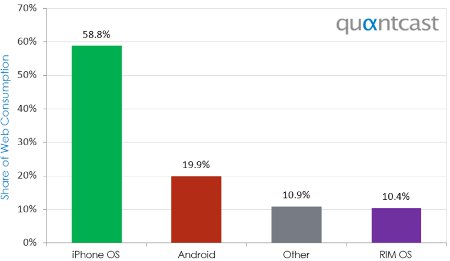
OS share of mobile web consumption , May 2010, North America
(Source: Quantcast)
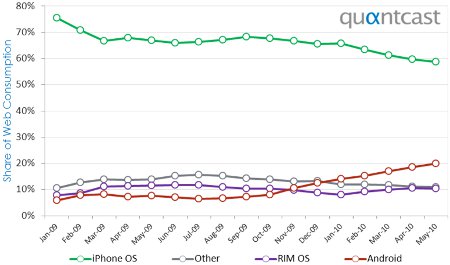
OS share of mobile web consumption , 2009 and 2010, North America
Source: Quantcast
(Click to enlarge)
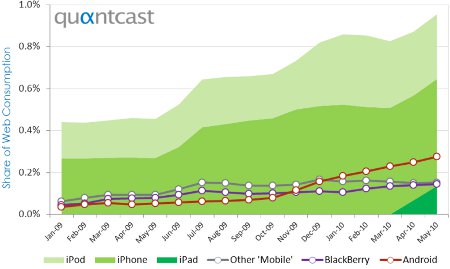
OS share of total (mobile and desktop) web consumption , 2009 and 2010, North America, including iPad
Source: Quantcast
(Click to enlarge)
Chitika: Motorola Droid still rules, as Evo 4G starts fast
While Quantcast looked at web traffic by mobile OS, Chitika zeroed in on Android, looking at traffic share by handset as well as by carrier. Chitika derived its figures by evaluating a sample of 821,201 impressions from the first two weeks of June coming into its advertising network, which once again appears to cover North America.
As can be seen in the pie chart below, th e Motorola Droid (pictured at right) continues to dominate in web traffic, just as it has ruled the roost in unit sales. The Verizon-sold Motorola Droid captured about a third of traffic, with 33.75 percent, followed by the mid-range, Sprint-deployed HTC Hero at 9.9 percent, and the similar Verizon-network HTC Droid Eris. Somewhat surprisingly, the original G1 is still in widespread use with 8.12 percent, followed by the 6.34 percent MyTouch 3G, which, like the G1, is offered by T-Mobile.
e Motorola Droid (pictured at right) continues to dominate in web traffic, just as it has ruled the roost in unit sales. The Verizon-sold Motorola Droid captured about a third of traffic, with 33.75 percent, followed by the mid-range, Sprint-deployed HTC Hero at 9.9 percent, and the similar Verizon-network HTC Droid Eris. Somewhat surprisingly, the original G1 is still in widespread use with 8.12 percent, followed by the 6.34 percent MyTouch 3G, which, like the G1, is offered by T-Mobile.
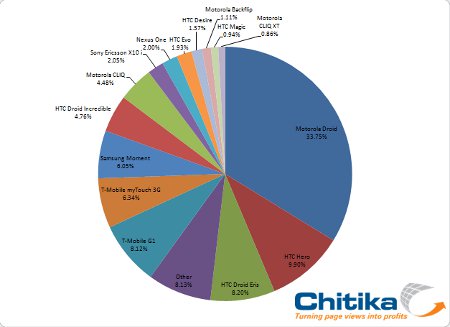
Android distribution (mobile traffic) by handset; based on sample of 821,201 impressions in first two weeks of June on Chitika's network
Source: Chitika
(Click to enlarge)
What's amazing about the Evo 4G, however, is that it's been on the market for less than two weeks. According to Sprint, it sold about 50,000 units of the "world's first 4G phone" on its June 4 launch date.
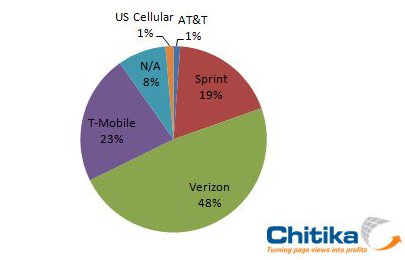
Android distribution (mobile traffic) by carrier; based on sample of 821,201 impressions in first two weeks of June on Chitika's network
Source: Chitika
The Android handset breakdown appears to more or less echo AdMob's somewhat similar report in March. The mobile advertising and research firm found that Android was available on 34 different devices from 12 manufacturers, with the Motorola Droid leading U.S. traffic usage at 32 percent. The Hero came in second at 19 percent, followed by the Dream (G1) and Magic (the MyTouch 3G) at 11 percent, and the Motorola Cliq at 10 percent.
The March AdMob report also found that Android traffic had grown at a compounded monthly rate of 32 percent each month over the last year, increasing from 72 million ad requests in March 2009 to two billion in March 2010. Still, this was about a third of the traffic generated by the iPhone and iPod Touch, which together represented 6.1 billion requests in March, according to the research firm.
Availability
The Quantcast blog showing all three cited mobile traffic reports may be found here. The Chitika announcement of its Android handset and carrier study may be found here.
This article was originally published on LinuxDevices.com and has been donated to the open source community by QuinStreet Inc. Please visit LinuxToday.com for up-to-date news and articles about Linux and open source.